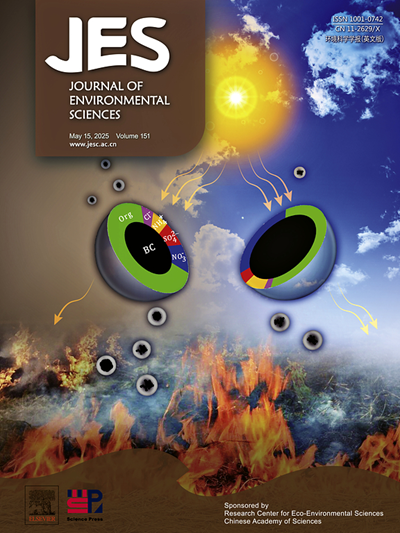Fe/N modified porous carbon nanofibers with encapsulated FeCo nanoparticles for efficient electrocatalytic nitrate reduction to ammonia
IF 5.9
2区 环境科学与生态学
Q1 ENVIRONMENTAL SCIENCES
引用次数: 0
Abstract
The efficient electrocatalytic nitrate (NO3−) reduction to ammonia (NRA) offers a sustainable alternative for both environmental remediation and ammonia synthesis. Developing advanced electrocatalysts with rationally designed spatial arrangement of active sites and optimizing the synergetic effect among components are crucial for high efficiency and selectivity. Herein, we present Fe/N active sites decorated on porous carbon nanofibers (CNFs) with encapsulated FeCo nanoparticles (FeCo@CNFs-Fe/N) as electrocatalysts for NRA. The FeCo@CNFs-Fe/N catalyst demonstrates exceptional performance, achieving a high ammonia yield of 498.18 μmol/(h·gcat). Meanwhile, the enhanced reduction activity, especially the reduction in overpotential by 0.565 V, is 3–10 times higher than that of FeCo-encapsulated and Fe/N-modified CNFs-based catalysts. The enhanced catalytic activity is attributed to the efficient structure design and optimized spatial distribution of active sites, which enhance the electron transfer rate and decrease the reaction energy barrier. Mechanistic studies reveal that the synergetic effect between encapsulated nanoparticles and surface-modified Fe/N sites plays a crucial role in promoting efficient nitrate adsorption and selective ammonia production. These findings highlight the potential of strategically engineered CNF-based composites for nitrate reduction and other advanced electrocatalytic applications.

包覆FeCo纳米颗粒的Fe/N改性多孔碳纳米纤维用于电催化硝酸还原制氨
硝酸氮(NO3−)高效电催化还原制氨(NRA)为环境修复和氨合成提供了一种可持续的替代方案。开发先进的电催化剂,合理设计活性位点的空间布局,优化各组分之间的协同作用,对提高电催化剂的效率和选择性至关重要。在此,我们提出了用包裹FeCo纳米粒子(FeCo@CNFs-Fe/N)修饰多孔碳纳米纤维(CNFs)上的Fe/N活性位点作为NRA的电催化剂。FeCo@CNFs-Fe/N催化剂表现出优异的性能,氨收率高达498.18 μmol/(h·gcat)。与feo包封和Fe/ n修饰cnfs基催化剂相比,其还原活性提高了3-10倍,还原电位降低0.565 V。有效的结构设计和优化了活性位点的空间分布,提高了电子传递速率,降低了反应能垒。机理研究表明,包封的纳米颗粒与表面修饰的Fe/N位点之间的协同作用在促进硝酸盐的高效吸附和选择性氨生成中起着至关重要的作用。这些发现突出了cnf基复合材料在硝酸盐还原和其他先进电催化应用方面的潜力。
本文章由计算机程序翻译,如有差异,请以英文原文为准。
求助全文
约1分钟内获得全文
求助全文
来源期刊

Journal of Environmental Sciences-china
环境科学-环境科学
CiteScore
13.70
自引率
0.00%
发文量
6354
审稿时长
2.6 months
期刊介绍:
The Journal of Environmental Sciences is an international journal started in 1989. The journal is devoted to publish original, peer-reviewed research papers on main aspects of environmental sciences, such as environmental chemistry, environmental biology, ecology, geosciences and environmental physics. Appropriate subjects include basic and applied research on atmospheric, terrestrial and aquatic environments, pollution control and abatement technology, conservation of natural resources, environmental health and toxicology. Announcements of international environmental science meetings and other recent information are also included.
 求助内容:
求助内容: 应助结果提醒方式:
应助结果提醒方式:


